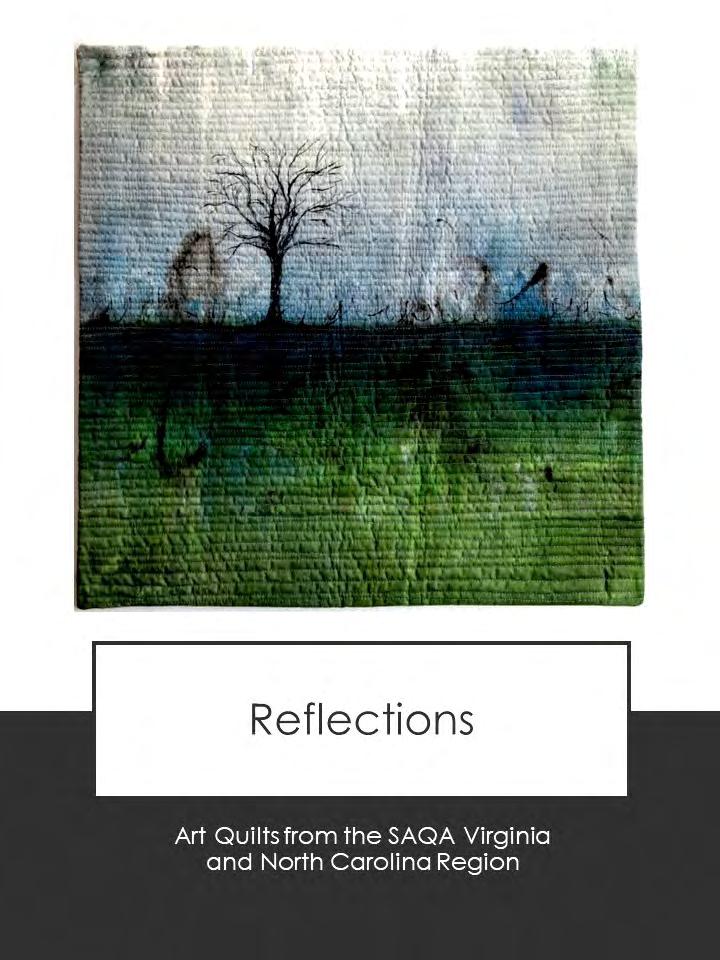

Reflections
Art Quilts from the Studio Arts Quilt Association, Virginia and North Carolina Region
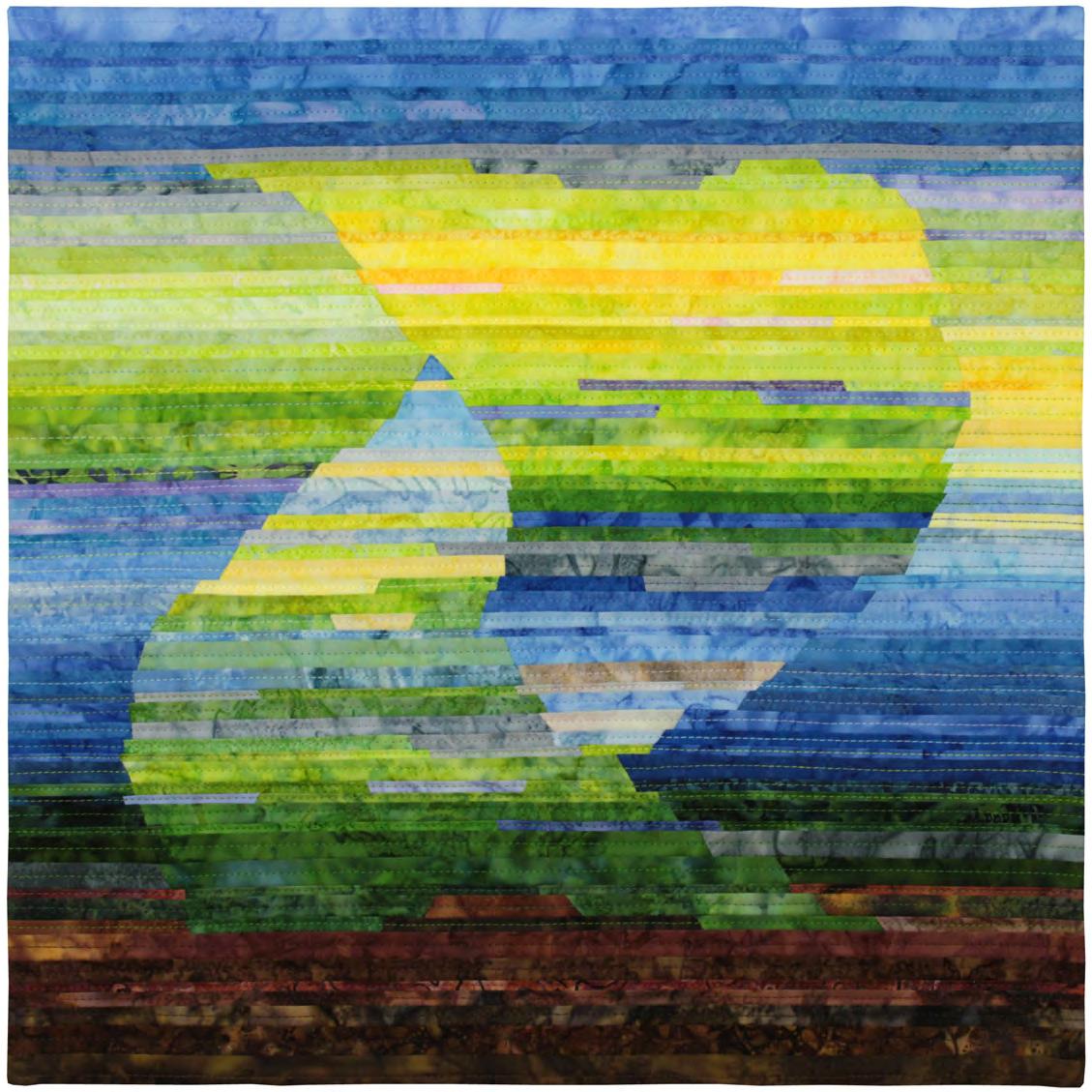
Premiere venue: Petersburg Area Art League, July 7 – August 5, 2023
Cover Art: Paula Dean, The Resilient Stranger
Inner Cover Art: Christine Hager-Braun, There and Then, Here and Now
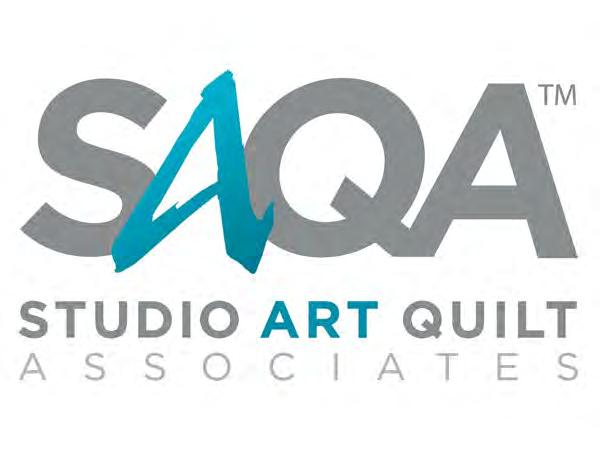
Contents copyright 2023 Art Quilts from the Studio Arts Quilt Association
Studio Art Quilt Associates, Inc. (SAQA) is a nonprofit organization whose mission is to promote the art quilt: “a creative visual work that is layered and stitched or that references this form of stitched layered structure.” Our vision is that the art quilt is universally respected as a fine art medium. SAQA’s core values are: excellence, innovation, integrity, and inclusion.
Over the past 30 years, SAQA has grown into a dynamic and active community of over 4,000 artists, curators, collectors, and art professionals located around the world. With our exhibitions, resources, publications, and membership opportunities, we seek to increase the public's appreciation for the art quilt and to support our members in their artistic and professional growth.
Catalogue Design: Annegret Fauser
Reflecting on “Reflections”
Art quilts that reflect the rich and diverse worlds of Virginia and North Carolina: the colors, shapes, textures, natural environments, structures, and cultures this was the prompt that thirty artists followed as they created their contribution to this group exhibition. Reflections can be the visual phenomenon of mirror images abounding in nature as much as in the windows of cityscapes; but reflections can also reference the mental act of contemplation and consideration. In both senses, reflection is the opposite of agitation and disquiet. This contemplative aspect pervades the creations that make up this collection of art quilts.
The works presented in this exhibition encompass numerous approaches: some are abstract, others are pictorial. Some use traditional techniques such as appliqué, others emphasize surface design. All, however, connect the process of artistic creation with reflections about the region on which this exhibition is centered: the U.S. states of Virginia and North Carolina. It is striking how the specificity of local experiences leads to broader themes explored in these individual artworks. Many of the quilts reflect on memory, personal ones of place whether Bradham’s Drug Store in New Bern, NC, or a grandmother’s kitchen and historic ones. At times, they are entwined.
Nature plays a significant role in this exhibition. The maritime and mountainous landscapes of Virginia and North Carolina find their expression in a substantial number of contributions, from ghost forests and coastal swamps to the peaks of the Appalachian Mountains. It is this close experience of the local environment that prompted the rich and diverse visual engagement with, and reflections of, the varied landscapes of the region. Nature also means human interaction with the natural world and the traces we leave, such as the gantry raised in the middle of coastal Virginia so that NASA could practice moon landings. Animals and plants are a key element of nature, and they have found their way onto these pieces. There are flies, bears, and birds, and there are flowers and trees the latter also serving as signifiers of solitude, mirrors of human identity and growth, and sentinels of human environmental impact.
These visual reflections invite us to take a step back from the urgency of the everyday and to contemplate how humans and nature intersect in this region, and what it means when we inhabit environments. They speak to us about the microcosm of individual experience and the human condition writ large. Each quilt measures 18 by 18 inches not quite a miniature but certainly a concentrated visual creation but each contains a world of meaning and experience, and together these artworks offer reflections on what it may mean to call North Carolina and Virginia our artistic home.
July 2, 2023
Annegret Fauser
List of Artists
Catherine Altice, The Flyswatter: Flies in the Kitchen
Arlene L. Blackburn, Field Notes: Focus
Leah Cooke, She Became Her Garden
Paula Dean, The Resilient Stranger
Lana Dragon, Vienna VA Reflections
Sarah Lykins Entsminger, At the Edge of the Water
Kerry A. Faraone, Confluence of the Shenandoah and Potomac
Annegret Fauser, Ghost Forest #1
Ann M. Flaherty, This Boy
Debbie Gebbie, Pearl Moon
Gwen Goepel, Flowing Through My Life
Christine Hager-Braun, There and Then, Here and Now
Ellen Lindner, Seeking the Horizon
Janet Acuff Marney, Flowering Dogwood
Sally Harcum Maxwell, Apollo and Poseidon: Reflections of Poquoson
Aynex Mercado, Air Force Memorial
La Veda Longfellow Myers, Bearries and Blossoms
Olena Nebuchadnezzar, Overgrown Pond
Patti Louise Pasteur, Bradham’s Drug Store
Jenny Perry, Lake Resident
Karen Ponischil, Blue Skies
Susan L. Price, Blue Ridge Heron
Mary A. Ritter, Solitude on Currituck Sound
Joan C. Rutledge, Enlightenment
Margaret Duncan Storti, Tidewater Sunset
Pamela G. Swearingin, The Quiet Place
Naomi Swyers, Quiet Spirit
Karin Täuber, Natural Bridge
Betsy True, Wetlands Reflections
Kevin Womack, Crossed Out
ART
I keep my small backyard studio door open on warm days, which requires me to staple a makeshift screen curtain to the doorframe to block out the flies and hornets. There’s a bright green plastic swatter, placed on special cup hook near the door. One day, as I was walking out the door, I had to stop for a moment. Where had I seen this green flyswatter before? I had been listening to music in my studio. One of my favorite songs came on: “Angel from Montgomery” by John Prine. Two lines in the song hit home, “There’s flies in the kitchen I can hear ’em there buzzin’.” Suddenly, I was transported back to my grandma’s kitchen, reflecting on her cooking, cleaning, and telling me magical stories. My first four years were spent growing up in her house in West Salem, VA. She always kept her flyswatter on a special cup hook near the kitchen door. She’d tell me to go get the flyswatter when those pesky bugs were getting out of hand. My grandma was a Zen master with her flyswatter!
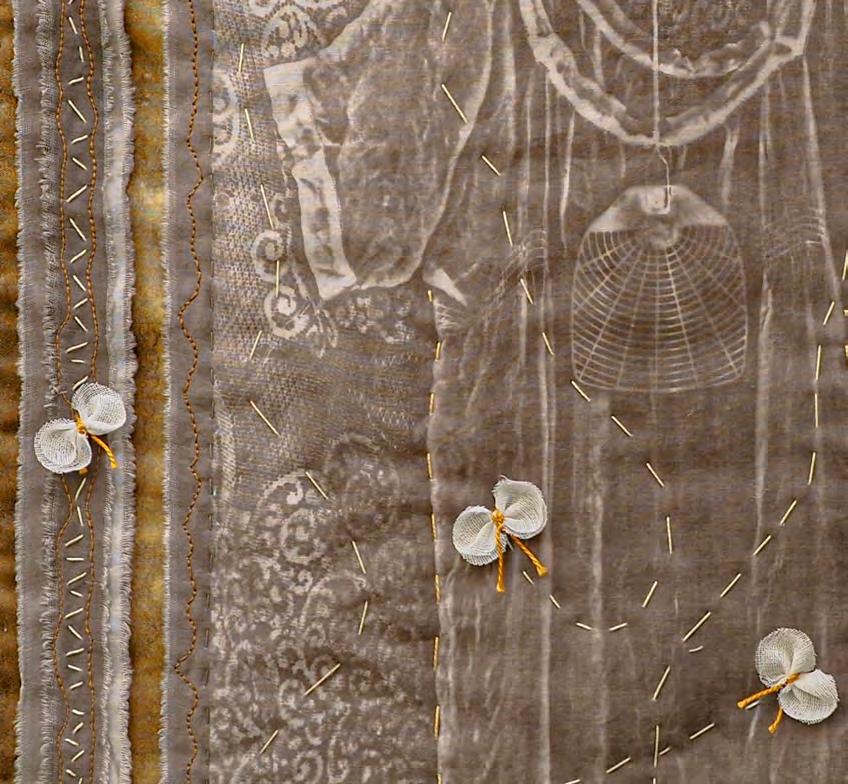
The quilt was constructed using handstitching, straight-stitched and free-motion machine sewing. The cotton fabric is a teatoned cyanotype from a negative film I printed, using my original photograph.
Catherine Altice is a mixed-media artist. Her studio practice involves painting, drawing, photography, textile arts, and jewelry making. She has also been trained in dance and performance arts. Catherine has an MFA from Northern Vermont University and currently teaches as a Lecturer of Art at Appalachian State University. When she’s not working in her studio, Catherine enjoys being outdoors, either gardening or running along a country road at a slow and steady pace.
www.tinroofstudio.com
Catherine Altice
Todd, NC

The Flyswatter: Flies in the Kitchen
My “Field Notes” series has evolved into a study of texture found in landscape that references time. In “Focus” I am exploring the singular moment when color and depth catches my eye and draws me into a scene. There are distinct elements that give me a sense of time relevance and the texture of purpose that tells the story.
Original surface design by artist; machine quilting. Materials include: rust; Procion MX dyes; cotton fabrics; poly-rayon threads; wool batting.

Arlene L. Blackburn is a textile artist from Union Hall, VA. Her art practice is greatly influenced by her personal history, sense of place, and certainly the researching of her subjects. This love of history and the land informs her approach to creating artwork. There is a natural tie-in to structure, landscape, and the study of “who” inhabited the space. Mark-making is usually incorporated into Arlene’s work to reference the influence of action in a place. Whether it is in her recent “Field Notes,” “Homestead,” or “Piedra Lumbre” series, each stroke and shape of her surface-design technique is full of historical texture and meaning.
www.ArleneBlackburn.com
Arlene L. Blackburn
Union Hall, VA

Field Notes: Focus
Is there truthfulness when you look in the mirror? I do not want my quilts to reflect the surface (your iPhone can do that) but rather to penetrate deeper inside. My mirror goes to the heart. Ever changing, we become what we know. We reflect our experiences. This piece is the first in a series of quilts about our evolving nature. The textures are reflections of life: some fabrics are coarse, some soft to the touch, some fraying at the edges. Memories (recycled clothing) are woven in with the patterns. The colors are strong; the greens of North Carolina dominate. The lines dance in the wind. The composition is direct; she is growing.
Hand and raw-edge appliqué; machine quilting. Materials include: recycled clothing (cotton Mother’s Day dress, silk dresses from my daughters’ weddings, silk scarf, cotton dresses, cotton shirts, rayon blouses); solid commercial fabrics; recycled cotton-print upholstery fabrics.
Leah Cooke: Nature, travel and the love of color are the foremost influences on my work. My journey began in the 1970s experimenting with natural dyes and fabric/surface design. I am influenced by the simple and colorful paintings and cutouts of Matisse. I look for strong lines, color, pattern, and composition in my work. I want to evoke a feeling. Throughout the years, this path led to collaborations, artist residencies, solo shows, commissions, and exhibitions of art quilts in the United States, United Kingdom, and Europe
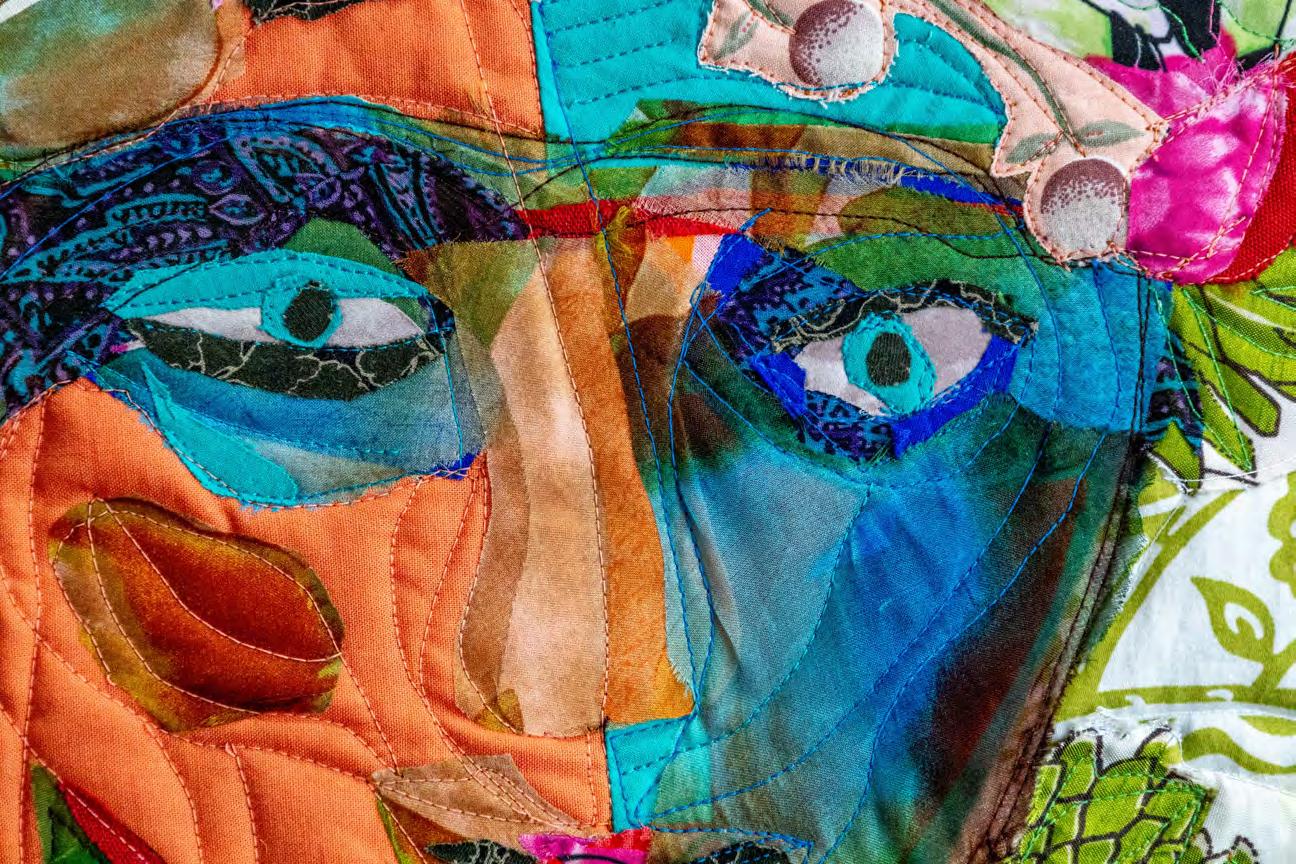
Leah Cooke
Cary, NC

She Became Her Garden
Have you ever wondered why a tree’s branches grow the way they do? Why some limbs cross and other grow at odd angles and different directions? A tree’s unique limbs are the result of many life events. Storms, heat, ice, and wind can alter the shape year after year. These limbs have the amazing ability to adjust and adapt to become stronger and ready to withstand the next storm. I often spend time gazing up at these resilient wonders and reflect upon my own individuality. I think about how my personal growth has been impacted by life storms, and how these events have helped shape me into the unique person that I have become.
Cotton fabric painted with acrylic paints and India ink, heavily stitched with organic imperfect stitches.
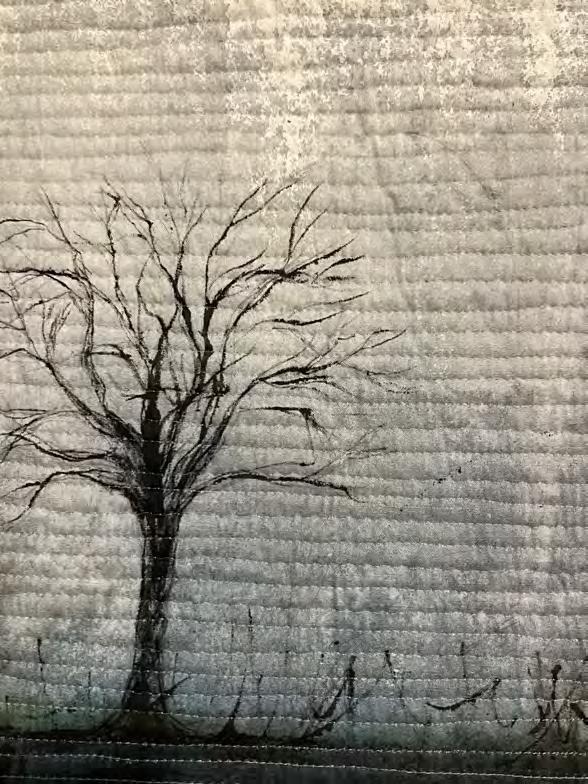
Paula Dean: My background is filled with experiments in different media. As long as I can remember I have tested the limits of my supplies, breaking rules and finding new ways to create. I enjoy incorporating layers of fabric, paint, paper, and dye to create unexpected and sometimes chaotic results. I create quickly with intuition and spontaneity. I enjoy pushing design elements to the edge to add excitement and artistic energy. Conversations with my pieces throughout the creative process help me evolve as an artist, taking the time to listen to hear what the next step wants to be. Working this way builds a deep connection to everything I create. I combine my love of mark-making with that of inks and paint. The permanent imperfect marks do not allow perfectionism to be present.
www.studioonthebluff.com
Paula Dean
Barhamsville, VA

The Resilient Stranger
I moved from the Midwest to the history-rich and diverse world of Virginia. My illustrations reflect the twenty years of having once lived in the town of Vienna, VA. I created historical illustrations within the area, with the awe of the Historic Energy always reminding me of a bygone era. The town has a long and illustrious history dating back to the eighteenth century. The Freeman Store has been a store, home, train depot, hotel, hospital, fire department, and an officers’ quarter on both sides of the Civil War. The Presbyterian Church (built in 1874) was originally organized by nine members, seven of which were women. The church still continues services today. Shortly before I moved there in the mid-1990s, the Red Caboose was unveiled for Vienna’s 100th birthday: it could have served the Washington & Old Dominion (W&OD) Railway within the area. Reflections of another time still seem to linger in the air.
I digitally scanned and arranged my original pen/ink and pencil drawings that I created while watching Civil War reenactors with my computer software then printed them onto cotton fabric. They were lightly painted with white fabric paint-dye to give an airy and lingering appeal. I machine free-motion quilted with cotton thread then completed the art quilt with pierced border binding. Materials include: fabric dyes; paints and pencils; cotton fabric and thread.
Lana Dragon: I received a BFA from The Ohio State University and attended two years of independent study at the Chicago Institute of Art and the American Academy of Art in Chicago. I soon developed my own style and skill with the diverse media of clay. I created hundreds of traditional works and clay art using my illustrations and photography screened directly onto the clay. I taught ceramics for thirteen years and conducted several traditional Japanese Raku Firing workshops. Moving near the DC area, I became a graphic illustrator for commercial/corporate and government agencies. I also grew from clay into cloth to learn traditional quilt making. I have completed several themed art-quilt series, featured in Quilting Arts magazine, and I have had numerous exhibitions. My love of creating and sharing art quilts continues.

Lana Dragon
Martinsburg, WV
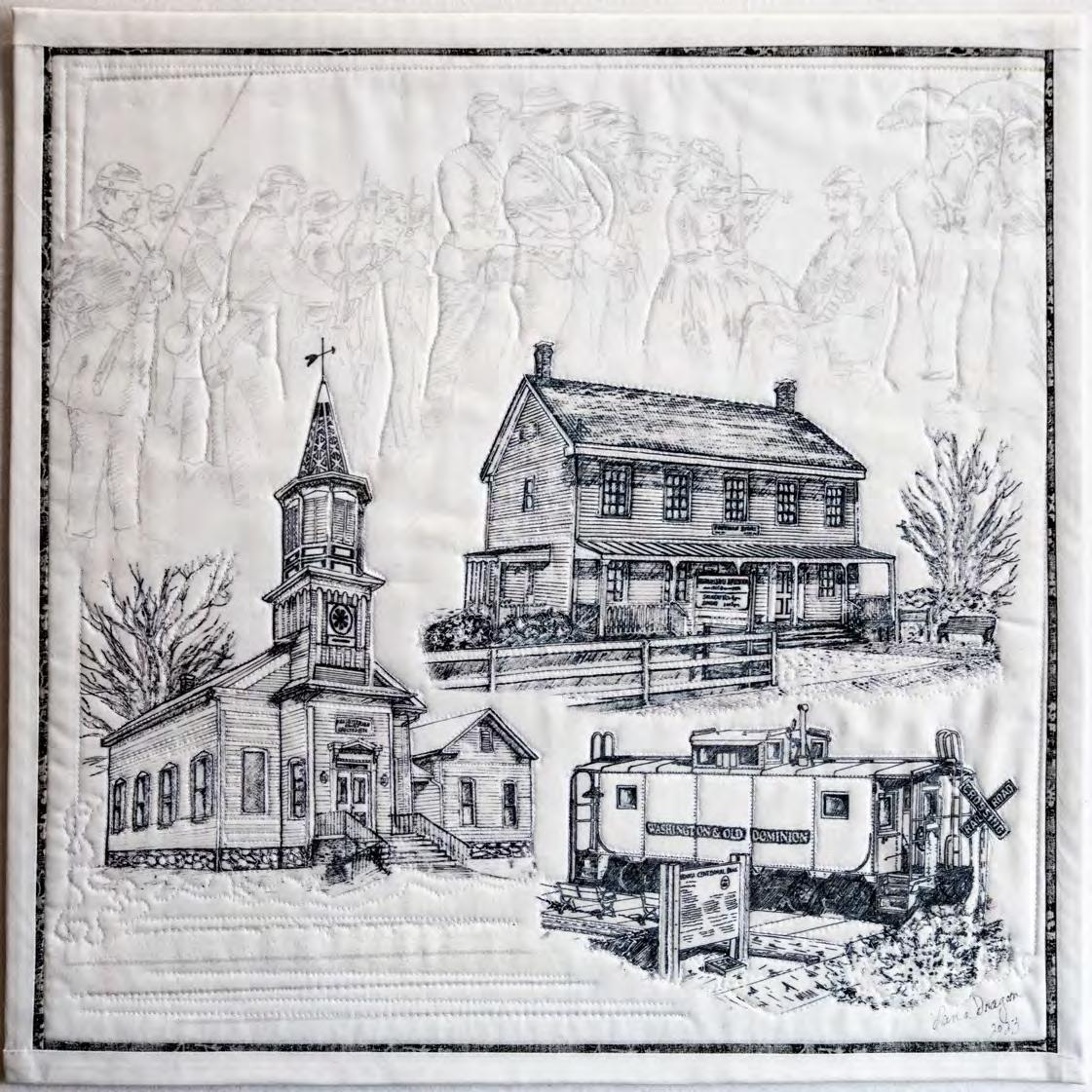
Vienna VA Reflections
Water, either still or moving, has long been an inspiration for my artwork. The calming and centering nature of water remains compelling. This quilt imagines the viewer standing at the edge of a lake with the reflection of the sky on the surface as the water slowly moves away with the breeze.
Painting; machine appliqué; machine quilting. Materials include: hand-dyed and commercial fabrics; inks; a variety of threads.

Sarah Lykins Entsminger is an artist, photographer, writer, and curator. Her contemporary textile art and imagery reflect memories of place and the natural world. Writing as well as curating exhibits allow her to mix her passions for artwork, photography, and language together to create a new visual experience. Her work is designed to draw others into an appreciation of mixed-media art and a critical understanding of the diversity of artistic expression. It has been shown in museums, galleries, and exhibitions around the world, with commissions held in private collections. Sarah is a Juried Artist Member of SAQA and a board member of the Virginia Quilt Museum, and she actively participates in a wide variety of artsrelated organizations.
https://www.studioatripplingwaters.com
Sarah Lykins Entsminger
Ashburn, VA
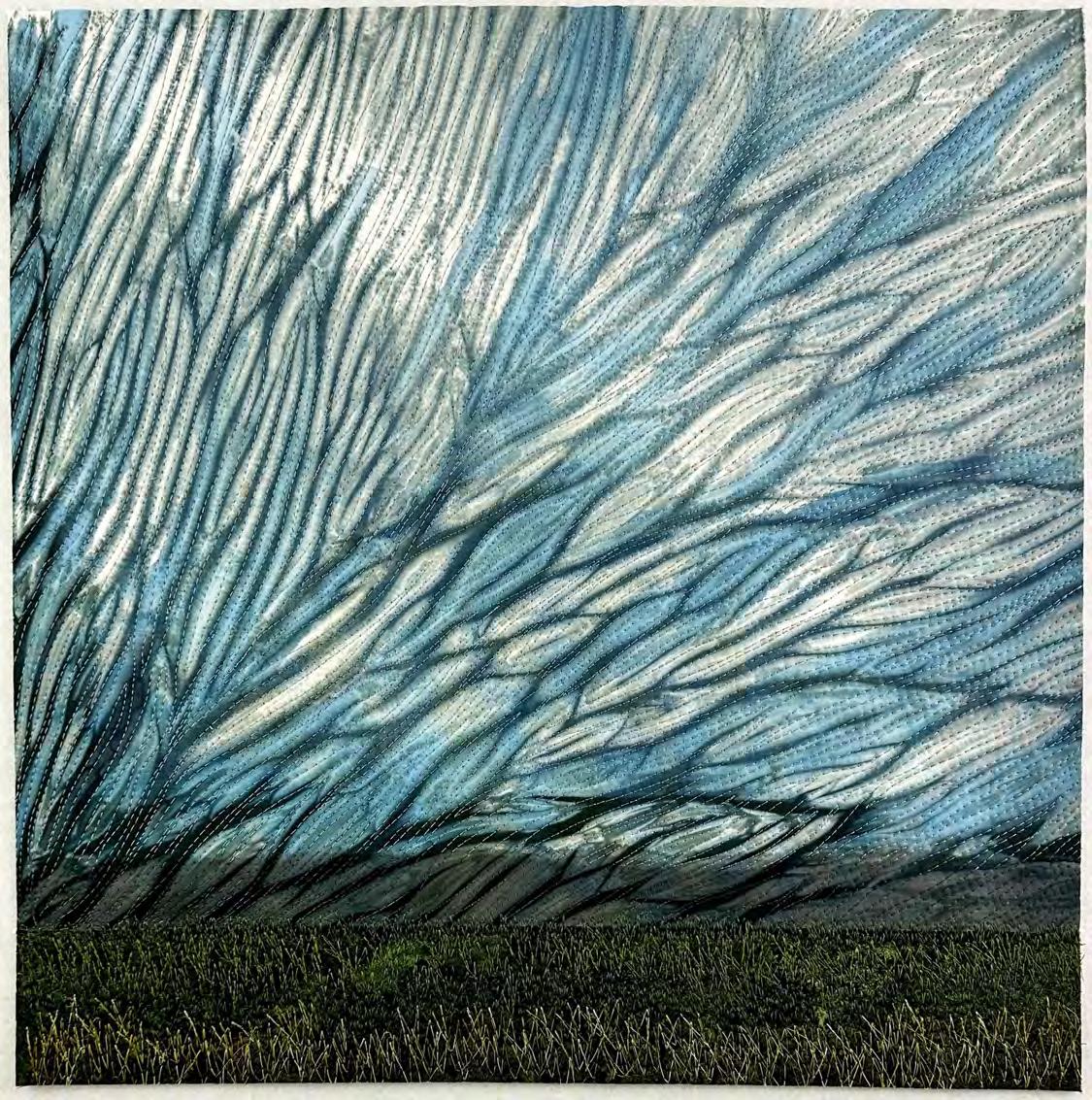
This is the confluence of the Shenandoah and Potomac Rivers at Harper’s Ferry (VA). Seven years ago we lost a young friend to the dangerous undertow, though the rivers both look so calm...
Torn-fabric collage. Materials include: 100% cotton batiks and thread.
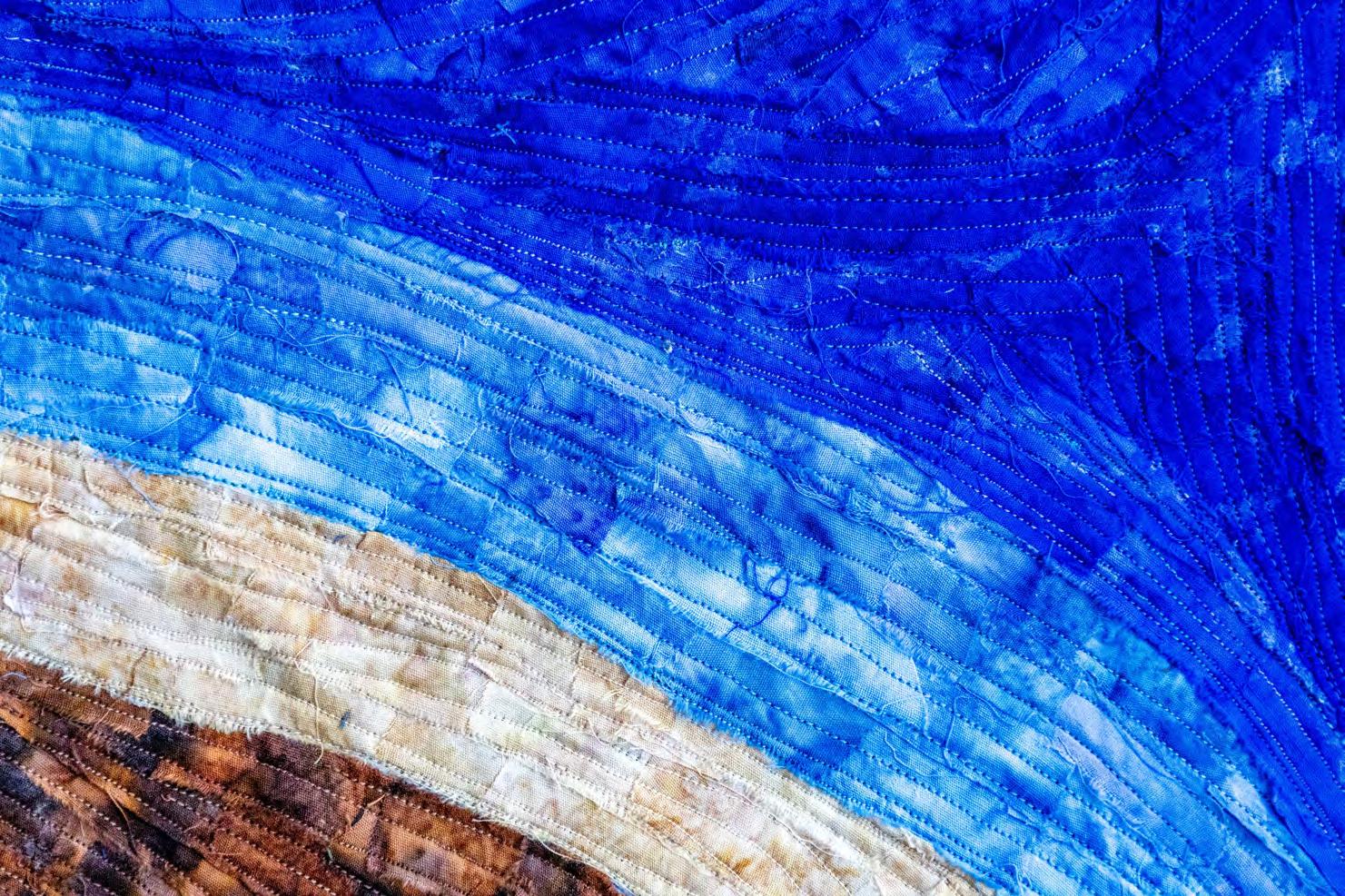
Kerry A. Faraone
Purcellville, VA

Confluence of the Shenandoah and Potomac
I have become obsessed with the ghost forests that line the coast of North Carolina, which I started to document with my camera in 2020. Along the Albemarle Sound, these groupings of dead and dying trees expand dramatically while also decaying through storms, rain, and sunshine. I based this quilt on a photograph I took in the summer of 2022 at the edge of the Nags Head Woods Preserve. These three trees have since been uprooted by a massive storm; only the roots are visible now. This quilt is the first in a series of works dedicated to this fragile ecosystem simultaneously beautiful and melancholic. The series builds on my own photography, using fabrics I painted and printed.
The fabric is painted and mono-printed with pigments dissolved in soy milk. I transferred the manipulated photograph, layered the bottom of the quilt with cheesecloth, stitched the quilt sandwich, and embellished the piece. Materials include: cotton fabric; soy-based paint; photo transfer; 80/20 batting; thread (cotton, monofilament, polyester); glass and stone beads.

Annegret Fauser is a fiber artist whose work focuses on the intersection of nature and culture. Born in Germany and now residing in North Carolina, she has lived in Ghana, France, Great Britain, and Australia before moving to the United States in 2001. Together with travels to countries as varied as Italy and India, these different cultural frameworks have shaped both her life and her work. Her recent art explores the fragile ecosystems of the Albemarle Sound (Outer Banks, NC), where the impacts of global warming, human expansion, and nature’s resilience create a beautiful albeit precarious environment. Between 2018 and 2020, she completed an advanced (Level 4) City and Guild (U.K.) accredited course, followed by a Master Practitioner Course with the School of Stitched Textiles (2022).
https://www.afauser.com
Annegret Fauser
Chapel Hill, NC
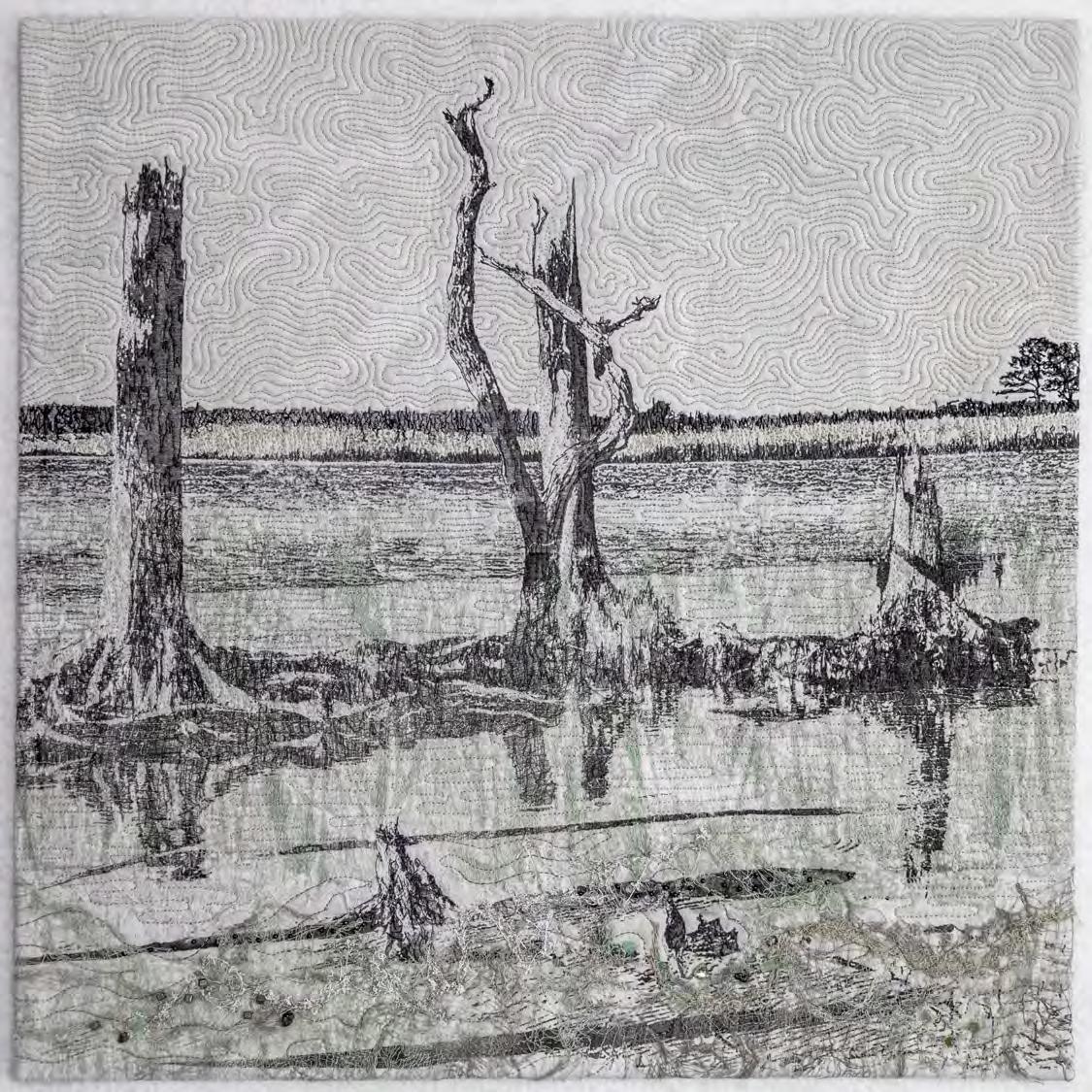
Ghost Forest #1
This Boy is stepping into a new landscape of life. We excitedly watch him grow into the person he is meant to be.
Artist’s photo transfer; raw-edge appliqué; machine stitching. Materials include: hand-dyed silks; silk mesh; various threads.
Ann Flaherty has utilized her imageination to create image-based fiber art and to curate exhibits that have been shown across the country and throughout the world. A born activist, often her work is a reaction to situations both personal and public, with a special emphasis on the many cultural influences of our world.

Ann M. Flaherty
Sanford, NC

Boy
“Pearl Moon” was inspired during a drive when I spotted the most gorgeous moon rising over a mountain ridge near my home in Asheville, NC. When I googled “pearl moon” I found that the moon is a symbol of renewal, and pearls are symbolic of peace. To me, “Pearl Moon” turns out to be a perfect visual metaphor of the need for peace in our culture and throughout the world.
Botanical contact prints (eco-print); hand- and machine-quilting; raw-edge appliqué. Materials include: vintage silk kimono (moon and sky); commercial cotton; repurposed cotton cloth; cotton thread.

Debbie Gebbie is an Asheville-based fiber artist inspired by the trees and mountains that surround her home. Her artwork begins with steaming local leaves on fabric to make botanical contact prints. She loves the process because the result is always a surprise that reveals natural depth and rustic beauty. Her leaf prints are enhanced dyes, metal leaf, and hand stitching. Each is a unique work of art that is the foundation for wall art, journal covers, and more. Debbie’s art quilts have been displayed by SAQA in exhibitions across many states. Her work has been awarded ribbons in juried quilt shows such as the Asheville Quilt Guild, and the Mancuso Quiltfest in Greenville, SC. Her work can be viewed at Marquee in the RiverArts District.
https://www.debbiegebbie.com
Debbie Gebbie
Asheville, NC
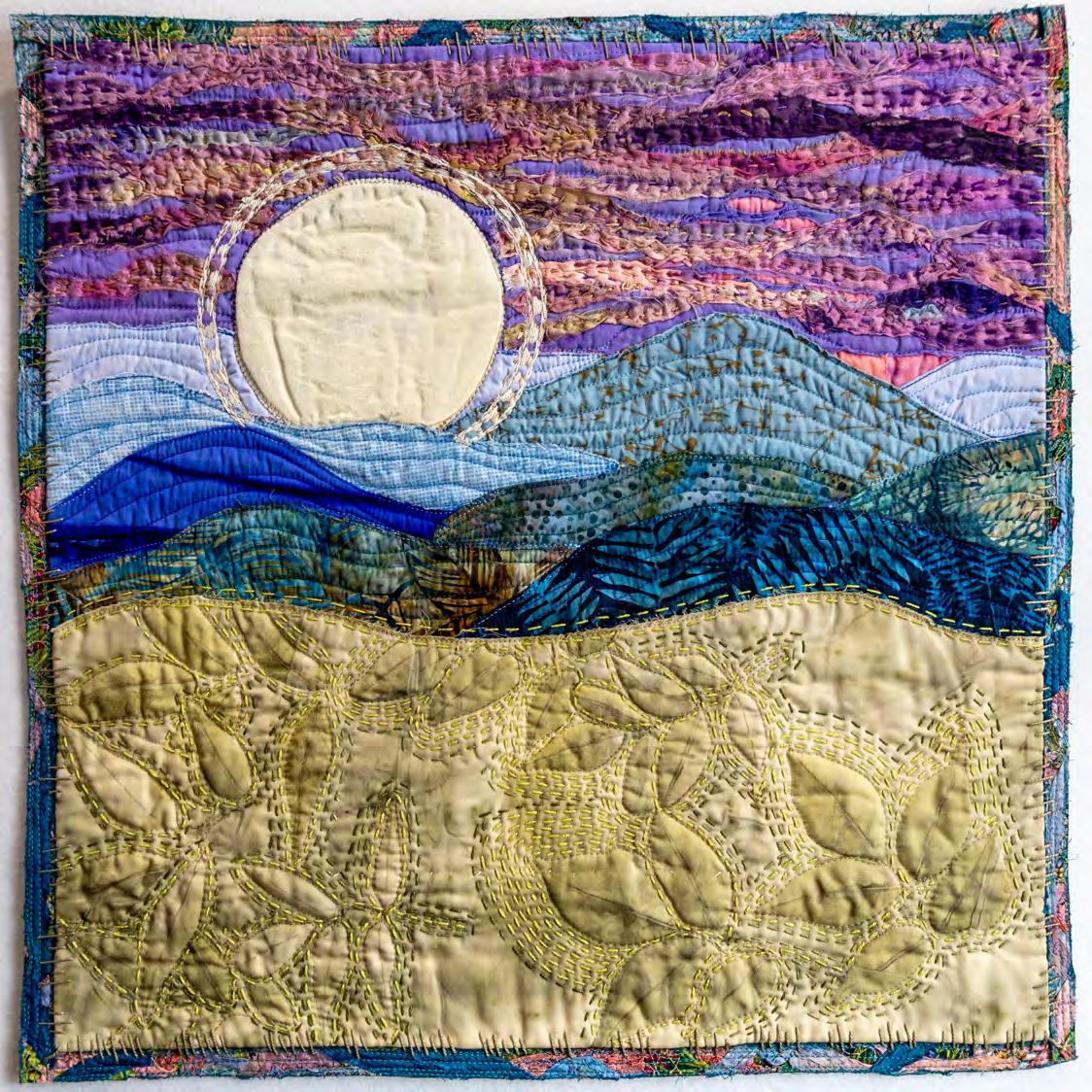
Pearl Moon
I chose to reflect on the richness of my life, specifically since 1999, when I started sharing time between two amazing natural worlds in North Carolina and Virginia. As I weave in and out of both my residences often feeling like flowing water the blues, greens, lavenders, and golden hues continue to amaze me. The sky, sand, ocean, clay, pond, and natural streams abound, as well as native animals, seashells/quartz, and outdoor activities, all adding to the natural beauty of both places.
As I look out of my very different kitchen windows I view: the NC Atlantic Ocean reflecting with the sun’s sparkling diamonds on the waves, alive with jumping dolphins while pelicans fly overhead, marshy grasses swaying from the ocean breeze...
…and the VA mountain paradise of the wind-blown glistening pond with ducks swimming, frogs singing, and herons flying high. From our beach resort to our secluded mountaintop forest... back and forth I go... experiencing, sharing, and preserving a sense of adventure for future generations!
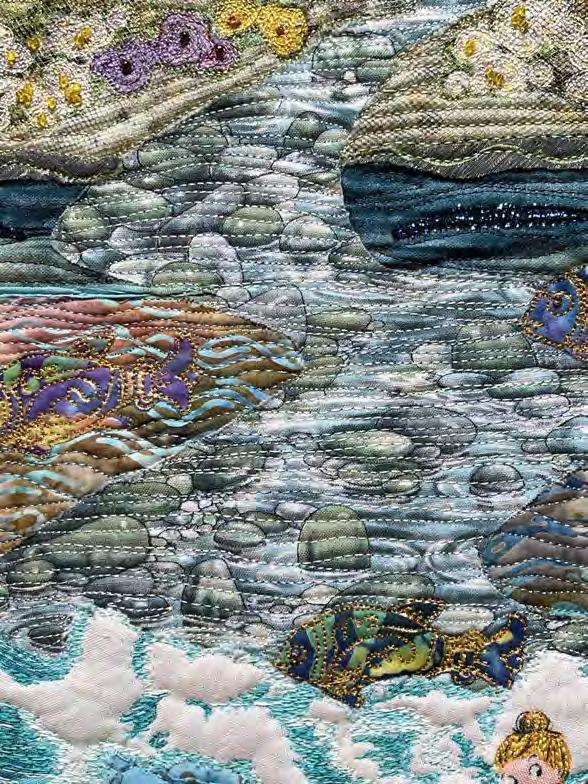
Raw-edge machine appliqué; free-motion quilting; hand embroidery; beadwork. Materials include: batiks; commercial fabrics; silk; Hobbs silk batting; threads (Aurifil, Sulky Invisible, YLI Brilliance metallic luminous, WonderFil perle cotton); silk ribbon; netting; tulle; beads; crystals; cheesecloth; yarn.
Gwen Goepel has experimented with many forms of art since childhood. She has been inspired by nature, travel, interior design, family, and a great appreciation of good fortune. Gwen’s work often fluctuates between the natural worlds of the oceans and the mountains, sometimes including both. She uses a variety of fabric and fibers, layering them into interesting textures, adding embellishments and detailed quilting... while enjoying both the creative process and the serendipitous nature of the outcome of her memories, worldly encounters, and imagination.
Gwen Goepel
Floyd, VA

Flowing Through My Life
Reflecting on North Carolina compels me to look back at my origins in Germany. I grew up in a rural area with poor soil, vast forests, and long, icy winters. Spring and summer were short. People worked hard but opportunities to thrive were limited. I always wanted to move away: away from the gray fog, the constraints of my environment, my own feeling of inadequacy as I silently struggled with depression.
In 1999, my husband and I moved to North Carolina. Here I embraced a new job, new friends, new possibilities. A child, a dog, a house. And so much more sunshine! Yet there were phases of darkness due to my depression. Eventually, I reached out for help, learned to heal, and developed resilience. While past and present will always be intertwined, old stories fade away yielding space for courage, confidence, and contentment. In North Carolina I flourished in a way I never thought possible.
May my story encourage others to move forward, go on a journey, and find a path to turn There and Then into Here and Now!
Machine piecing and quilting. Materials include: batik and solid cotton fabrics; cotton batting; cotton and polyester threads

Christine Hager-Braun grew up in Germany. After receiving an MS in Biology (1994) and a PhD in Biochemistry (1997), she and her husband moved to North Carolina to continue their research interests. Now a full-time fiber artist, Hager-Braun creates art quilts which are exhibited in regional and national group and solo exhibitions, and can be found in national and international private and corporate collections as well as two hospitals. She is also the recipient of various awards and grants. In her current artwork and speaking engagements, she focuses on the power of resilience, the strength of a positive mindset, and the importance of mental health. She aims to break down barriers, integrate opposing sides, and emphasize interaction, healing, and inner peace through her art.
https://soularpowerfabricart.com
Christine Hager-Braun
Durham, NC

There and Then, Here and Now
Perhaps the quest is more important than the destination.
Machine piecing and quilting. Materials include: cotton fabric hand-dyed by the artist.

Ellen Lindner: A former flight instructor, Ellen didn’t try her hand at art until her forties. After learning the basics, she quickly began to experiment, and over the course of years developed her own fabric collage technique. More recently, Ellen has been dyeing all her own fabric and working abstractly. She finds abstract design to be very challenging, which is exactly why she likes doing it. She often participates in juried shows and has won quite a few awards across the country. Now using her teaching skills at a lower altitude, she teaches online, as well as via her episodes on Quilting Arts (PBS) and The Quilt Show online. Ellen has also written two eBooks and several articles .
www.AdventureQuilter.com
Ellen Lindner
West Melbourne, FL

Seeing the call to “reflect the rich and diverse worlds,” I immediately thought of all the flowers and flowering trees we enjoy in our region. Considering which flower to celebrate, I decided that the Cornus florida would be perfect since it is the state flower of both Virginia and North Carolina. The white flower is normally depicted, but the pink varieties are also native, so I created a stylized blossom which I colored in three ways.
The symbolism of the dogwood flower includes purity, endurance, fidelity, and renewal. Some Christians believe that the four white “petals” (technically, bracts) symbolize the Cross of Christ, while the red indented corners show Christ’s blood, and the yellowish green center is the crown of thorns. The tree’s wood is sturdy enough to make daggers; hence the British “dagwood.” The bark makes a brown dye and is used as medicine. The dogwood tree provides beautiful colors, shapes, and textures in every season, making it a wonderful reflection of the abundant life in our region.
I drafted a stylized dogwood blossom with pencil and paper and cut out three from white, light pink, and darker pink solid fabrics. I used Mistyfuse to fuse scraps from my stash onto the three forms, gradating each from light to dark. The flowers were secured with a blanket stitch. Then I used many different threads for free-motion quilting, echoing the petal shapes. I added light and dark leaves to the green background and the words “Cornus florida.” Materials include: cotton scraps; cotton and cotton-blend threads; Mistyfuse.

Janet Acuff Marney: One of my earliest memories is arriving at my Appalachian grandparents’ house “in the holler” after a long car trip. It was night, and I was only four, so I was put to bed immediately. The next morning, I woke up between an aunt and a cousin, as we lay under a handmade quilt with hundreds of tiny scraps of color being illuminated by the morning sun. This is my first memory of a quilt, and it still evokes feelings of beauty, wonder, comfort, safety, and warm family connection. I knew that one day I would make quilts, too. Since learning how to make scrap quilts entirely by hand in the 1970s, I’ve explored and taught a variety of styles and techniques. My taste is eclectic, but most of my pieces contain flowers. I’m currently working on a flower series and an improv series.
https://www.instagram.com/janetamarney
Janet Acuff Marney
Fairfax, VA

Flowering Dogwood
Hayseeds and Muddytoes: Fond Memories from the Oral History of Poquoson, Virginia is the title of my mother’s book. If you had lived in Poquoson during her childhood, you were either a farmer (a “Hayseed”) or a waterman (a “Muddytoe”). During my childhood in the 1960s, that began to change, and a third employer brought new residents to the city: NASA and the Langley Research Center (LaRC). Virginia played an important part early in the Space Race, and in 1965 LaRC completed the gantry used to practice landings on a lunarlike surface for the Apollo program. That gantry is across the creek and within sight of my mother’s childhood home.
Today farming is no longer an important part of our community, but watermen still tend crab pots along the tributaries of the Chesapeake Bay. They provide an interesting counterpoint to the structures looking skyward, which are also part of the state’s heritage. I’m proud that the waterways of Poquoson are a part of Virginia’s reflection.
My photograph was printed on fabric and treated as a wholecloth quilt. I embellished and decorated it with thread and trims. Materials include: artist’s photograph printed commercially on fabric; thread; trims.
Sally Harcum Maxwell studied Art History at the University of Virginia, but she had not practiced those art forms considered more traditional before marrying a love of fabric inherited from her grandmother with her own need for self-expression. Strong ties to her family inform her art, and she spends much of her time on the family homeplace. The marshes and waterways of Virginia the landscape of her home regularly appear in her figurative work. What’s more, fabrics and trims from her grandmother and other relatives are often added to more modern materials. The combination is one of history and art, and one that she is pleased to share with others.

Sally Harcum Maxwell
Poquoson, VA
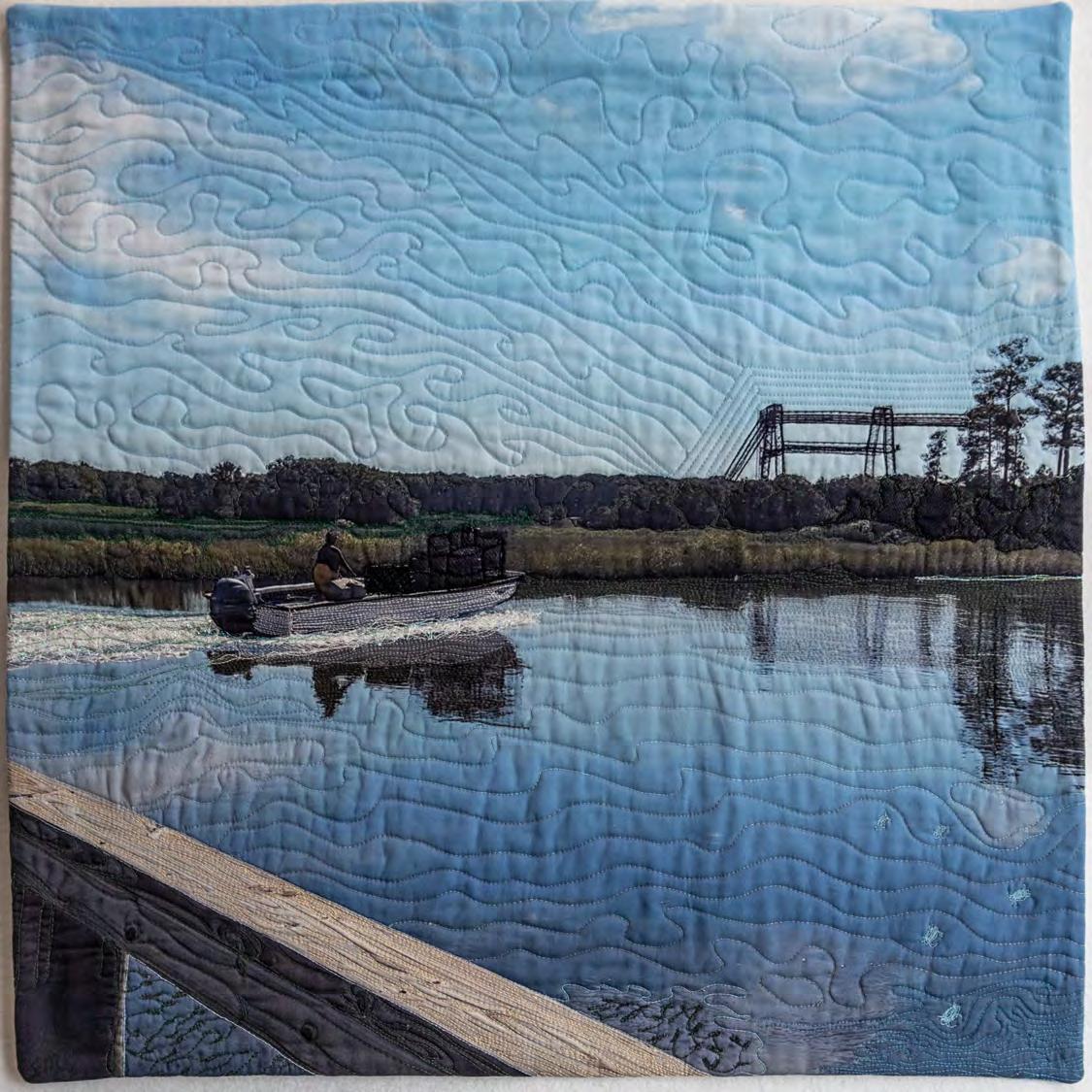
Apollo and Poseidon: Reflections of Poquoson
Of all the DC monuments, the Air Force Memorial is my favorite. It always surprises me that very few people know about it or acknowledge it, since it is so big and majestic. I wanted to point it out to make people appreciate it, visit it, and look up.
Machine piecing and quilting. Materials include: cotton fabrics; batting.

Aynex Mercado, originally from Puerto Rico, has been living in Maryland since 2008. She is an award-winning fiber artist who has exhibited nationally. She loves to translate what she sees into fiber art, and hopes her audience stops and notices the beauty that is all around us.
aynexquilts.com
Aynex Mercado
Frederick, MD

Air Force Memorial
“Bearries and Blossoms” highlights two of my favorite things about western North Carolina: the flora and the fauna. The brilliant colors of daffodils, tulips, peonies, rhododendrons, and roses vibrate against the lush green background. I love to stroll around Lake Junaluska, especially the Rose Walk. Countless roses of every hue blaze against the blue sky and reflect in the lake. It’s impossible to be a witness to this beauty and not feel uplifted.
North Carolina is the first place that I have lived where bears also preside. All the residents seem to have stories about a bear stealing their birdfeed, or entering their garage and eating their dog food, or hiking about their property. I haven’t seen one yet, except in friends’ and neighbors’ videos. Someday, maybe, I’ll see one from a safe distance. Until then, they’ll invade my artwork.
Hand-dyed fabric; leaf pounding; hand painting; fused appliqué; quilting. Materials include: cotton fabric; cotton thread; cotton batting; fabric paint.
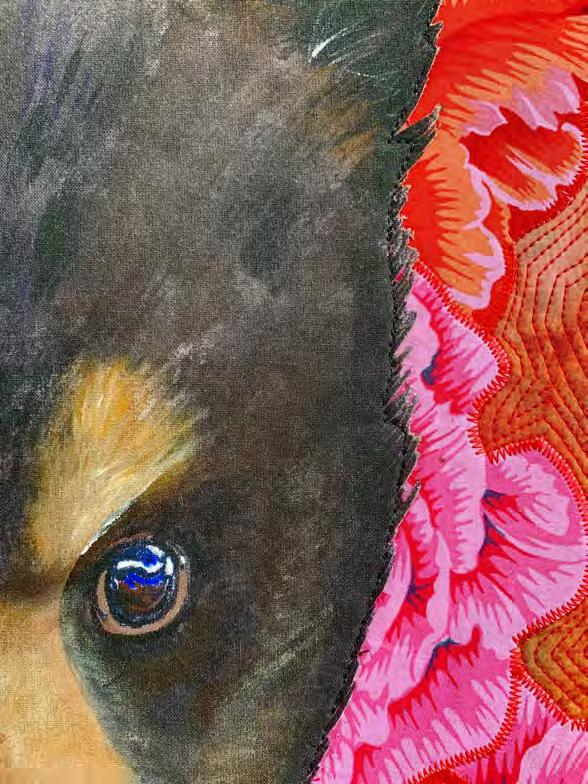
La Veda Longfellow Myers grew up on a farm in Indiana. She began sewing with her mother at the age of three. Her first quilt was created in 1970. Since then she has received a Master of Fine Art degree from the University of South Florida and has pursued multiple art media, but always returns to textiles. Her art quilts have been shown in many exhibitions around the country, including Houston and Paducah, as well as internationally. She has also curated art-quilt exhibitions in the Tampa Bay area which set new attendance records. She spends her time designing, creating art quilts, painting, making jewelry, beading, crocheting, doing Swedish weaving, hand embroidering, dyeing, surface designing... and rescuing cats.
La Veda Longfellow Myers
Maggie Valley, NC

Bearries and Blossoms
Virginia has such an amazing environment that as soon the warmth hits the ground, every plant just starts sprouting and growing, filling every space with lush vegetation, quickly creating a shady oasis around an old pond into which we gladly dive trying to escape from the summer heat. Deep shades of green and bronze are complemented with occasional highlights of fresh white and sky blue finding their way through the tree canopies.
Hand-dyeing; appliqué; embroidery. Materials include: hand-dyed silk; cotton; mixed thread; yarn.

Olena Nebuchadnezzar discovered traditional and art quilting during the 1990s American Quilt revival, and having an artistic background, she became a full-time studio artist in 1995 so as to work from home while taking care of her young children. She is an award-winner at national and international quilt shows.
https://olenaarts.com
Olena Nebuchadnezzar
King William, VA

Overgrown Pond
Bradham’s Pharmacy is an iconic landmark in New Bern, NC, known for the invention of “Brad’s Drink,” later renamed Pepsi-Cola. Some of us are old enough to have fond memories of sitting at a soda fountain enjoying an ice-cold glass of soda pop for just five cents. I took this photograph on an early spring morning and could just imagine the “reflections” seen in the drugstore windows that have changed since its opening in the 1890s.
Artist’s photograph enhanced using computer software commercially printed on fabric; collage and fusing; free-motion machine stitching; thread sketching. Materials include: cotton fabric and batting; cotton and polyester thread.

Patti Louise Pasteur’s awards include winning first place in the Altered Art category at the Simply Southern and Paper Artist Expo in Nashville, TN. She has also won awards in local art exhibits for art quilts in Hillsborough and Henniker, NH, and was a finalist for the Niche Awards in 2016. She has published articles in Stampington & Co. magazines, as well as for Quilting Arts, Cloth, Paper, Scissors, and Studios. She recently won the Bank of the Arts National Juried Exhibition Permanent Collection Purchase Award in New Bern. Exhibitions include a solo show for art quilts at the Robert E. White Gallery at Husson University in Bangor, ME. She has the honor of her quilt, “There Was One Left,” having been published in Sandra Sider’s Quarantine Quilts: Creativity in the Midst of Chaos (2020).
Patti Louise Pasteur
New
Bern, NC

Most mornings I walk at a lake close to my home in Swannanoa, NC. I often capture photos of the herons and egrets which reside there. This piece was inspired by my photos of one of the lake residents on a log, reflected in the water.
Fusible appliqué; thread painting; pastel dye sticks; free-motion quilting. Materials include: silk and silk/linen-blend fabrics; threads.

Jenny Perry is a Canadian/American textile artist, currently living near Asheville, NC. She began making traditional handpieced and hand-quilted pieces in 1975, and now enjoys processes such as fabric dyeing, painting, stamping, embellishment, and machine quilting, which make each piece unique. Her photographs are often an integral part of her textile-art designs. Many of her works are now in private collections in the United States, Canada, and New Zealand.
https://jennyperry.net
Jenny Perry
Black Mountain, NC Lake

Resident
This piece is a reflection of the blue skies in my home of North Carolina. It is also a warning that we need to take care of our piece of the earth by recycling, reusing, and reducing our waste .
Painted crumped Tyvek; machine- and hand-stitching. Materials include: recycled medical wrapping made of Tyvek; textile paint; polyester and perle-cotton threads.
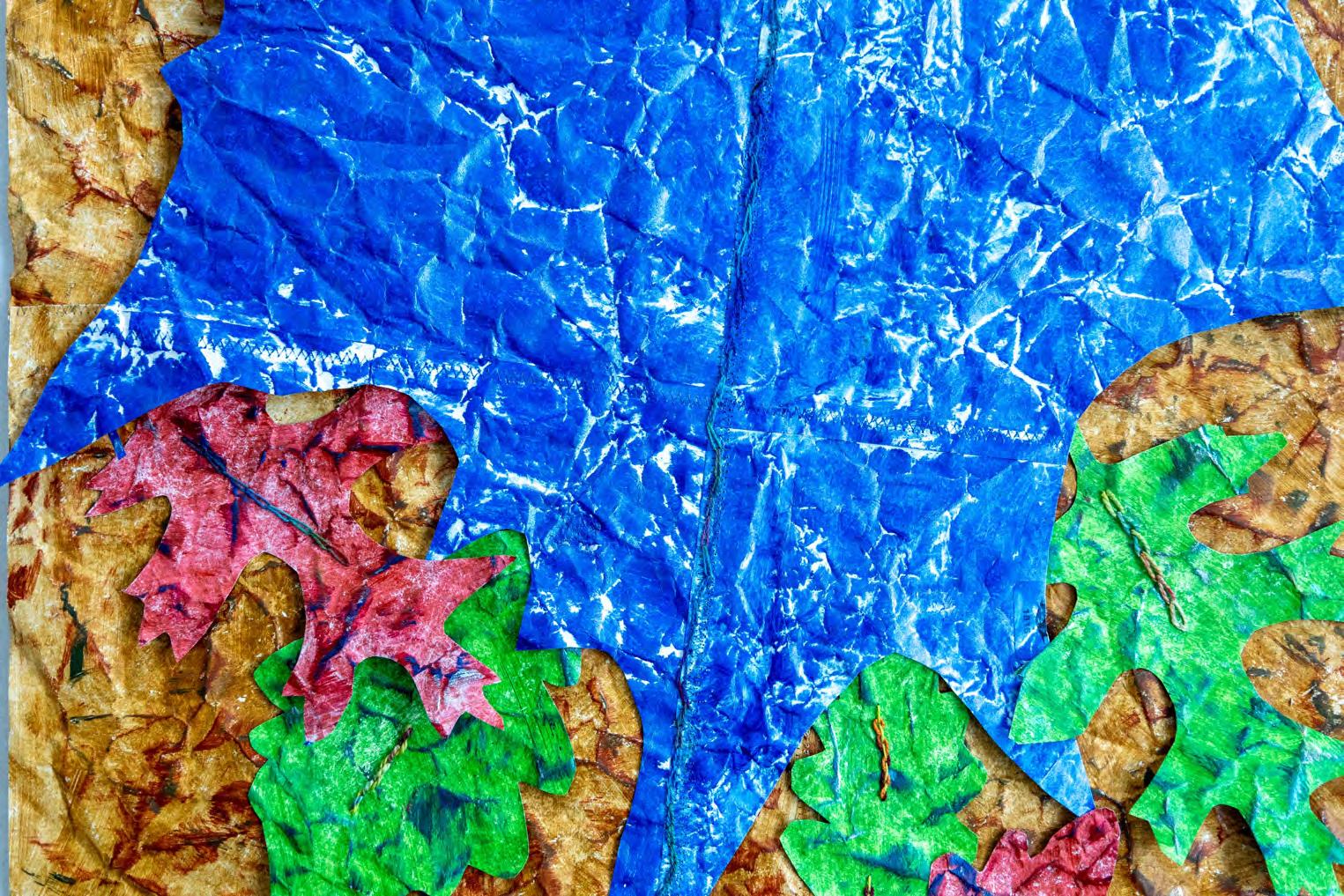
Karen Ponischil is a full-time nurse and textile artist living in North Carolina.
@kimmiekaren
Karen Ponischil
Charlotte, NC
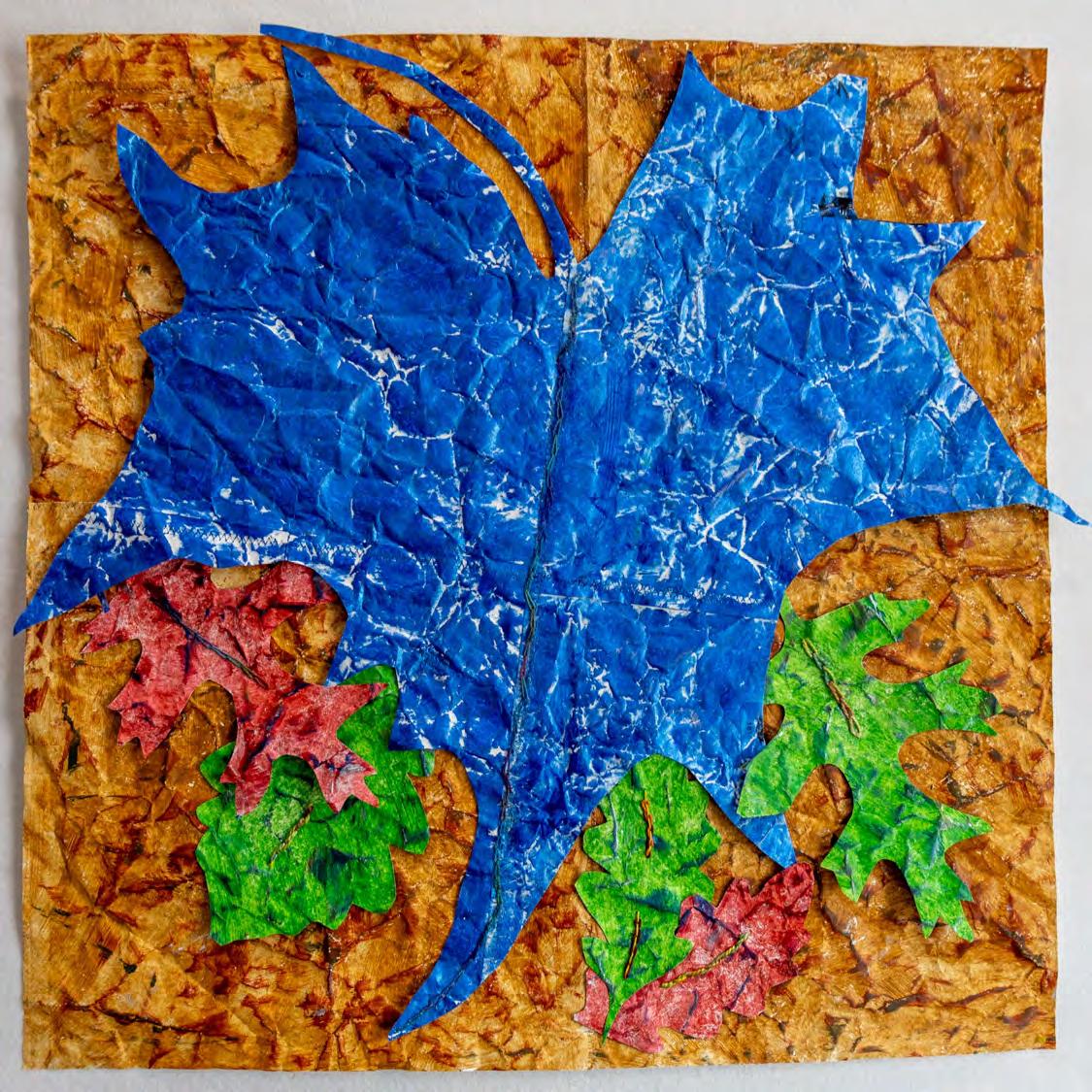
Blue Skies
Located on the Blue Ridge Parkway in southwest Virginia, Peaks of Otter Lodge is a peaceful and picturesque getaway. The lodge overlooks Abbott Lake, with the Peaks of Otter in the background. An evening walk around the lake resulted in a photo of a heron posing at the water’s edge. That photo was blended with another of the mountain as the basis for this “Blue Ridge Heron” quilt. The juxtaposition of the mountain and the heron reflect the geographic variety that makes up the beautiful state of Virginia.
Fusible appliqué; machine quilting. Materials include: 100% cotton fabrics; organza; hand-dyed shibori cotton; cotton and polyester threads.

Susan L. Price: I have been a “maker” since childhood and love playing with colors and textures. I use fabrics that are commercially produced as well as those I’ve created using various surface-design techniques. Inspiration can come from many places: a word or phrase, photos I’ve taken, elements of nature, and family memories. I work intuitively on a design wall, taking pictures as I work to evaluate progress. Many of my quilts reflect the natural world. I have had pieces published in Quilting Arts magazine (“Readers Challenges”) and in Jane Dunnewold’s Improvisational Screen Printing. I have exhibited quilts in “Sacred Threads,” Donna DeSoto’s “Inspired By” series, “Fly Me to the Moon” and “OurStory” exhibitions, and various SAQA regional shows. I continue to explore and create, which brings great satisfaction .
pgfiber2art.blogspot.com
Susan L. Price
Springfield, VA

Blue Ridge Heron
While walking the boardwalk in Duck, NC, I encountered this solitary tree, a true survivor of the storms that the Outer Banks encounters seasonally. It had a sense of solitude even as it was amongst a highly trafficked tourist venue. Poet May Sarton wrote, “Loneliness is the poverty of self; solitude is richness of self.” With the Currituck Sound as its background and facing the onslaught of tourists along the boardwalk, this tree indeed had a richness of self about it. It was lonely in that it stood alone, but its branches reached out in defiance to the elements it had survived, and basked in the sunlight of this perfect day, casting its careful reflection towards the shoreline. What a great way to celebrate the Outer Banks of North Carolina! I took the photograph with this challenge in mind.
Artist’s photograph; stitching to enhance the reflections and solitary emphasis. Materials include: cotton; silk and cotton threads .

Mary A. Ritter: Underlying all my work is a passion for travel going places, meeting people and recording the people and sites along the way. The photographs by my husband, Norm, and I provide an unending source of inspiration. My work has been exhibited at Emerald Art Center, Springfield, OR; Woman Made Gallery, Chicago, IL; The Arts Council, Fayetteville, NC; Page-Walker Gallery and History Center, Cary, NC; “Sacred Threads” in Wake Medical Center Reflection Gallery, The Mayton Inn, Cape Fear Studios, and Spartanburg Art Museum, SC. My work has been published in the SAQA Journal, Fresh Fish, A Better World, Backyard Escape, Sacred Threads (2019–22), and Imagining the View (all at Amazon.com). Solo shows have been exhibited at Cary Art Center and Chef’s Palette in Cary, NC .
https://maryritter.com
Mary A. Ritter
Cary, NC
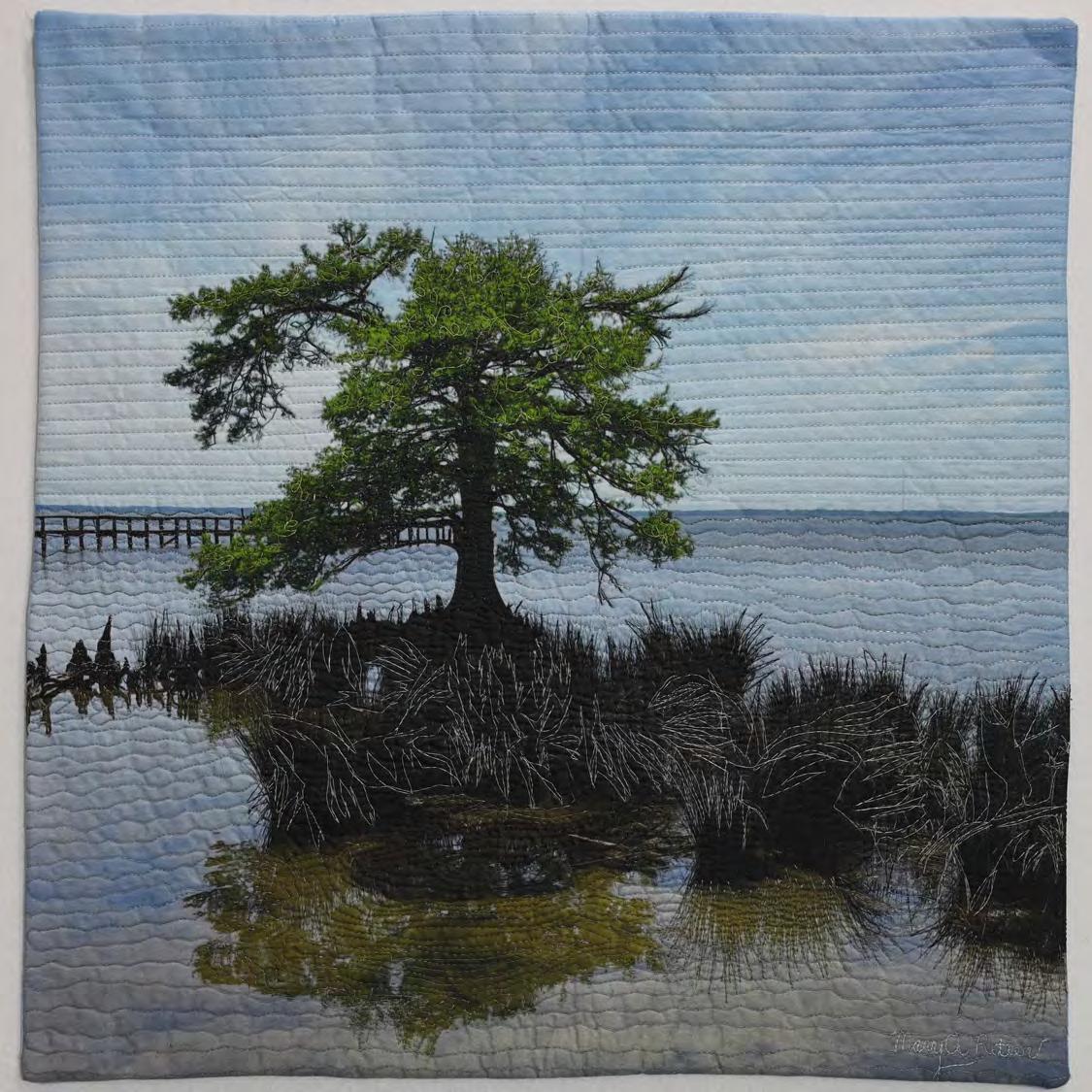
Solitude on Currituck Sound
The concept of reflection is larger than just what I see with my eyes, and as I take morning walks, I am drawn into a time of contemplation. This allows me the quiet to notice things I might miss in the din of everyday life. It is in these times that I might see a new bird, or notice the shape of a leaf or the way the light hits the water. “Enlightenment” came from my fascination of how light plays through the trees to create beautiful patterns in the water and sparkles on the reeds along the water’s edge. I have been to this place and had this meditative moment. When I moved to North Carolina, I was struck by the vivid colors of the sky, landscape, and water. The world of nature has always been my inspiration: it is there that I find the myriad of textures, shapes, and deep, rich, saturated colors.
The concepts for my pieces begin from my immersion in nature, which I translate through sketches or photos taken during my exploration and experience. “Enlightenment” was created by merging a watercolor with digital image manipulation. The image was printed on fabric and enhanced with machine quilting and collaged thread work. The foreground was left intentionally simple so that the viewer would be drawn back by the dappled light playing on the water and through the trees. Materials include: watercolors; photographs with digital enhancement; paint and Inktense pencils; Solvy.

Joan C. Rutledge: With a degree in fine arts and a thirty-seven-year career as a corporate graphic designer, I am finally able to pursue my dream of working as a full-time artist. I learned to sew by making traditional quilts, but quickly found myself drawn to making art quilts. As my work evolves, I find myself drawing upon my fine-arts background. I like to sketch and make small watercolors of my vision for the quilted pieces. Today, I find myself incorporating many techniques: drawing and painting on fabric, thread work and felting to evoke a special moment in time or place. Sometimes playing with paint and textures will inspire a piece, and at other times, the painted piece becomes the piece that ultimately gets quilted. Being a fiber artist allows me to communicate my artistic vision through paint, fabric, and thread.
Joan C. Rutledge
Clemmons, NC
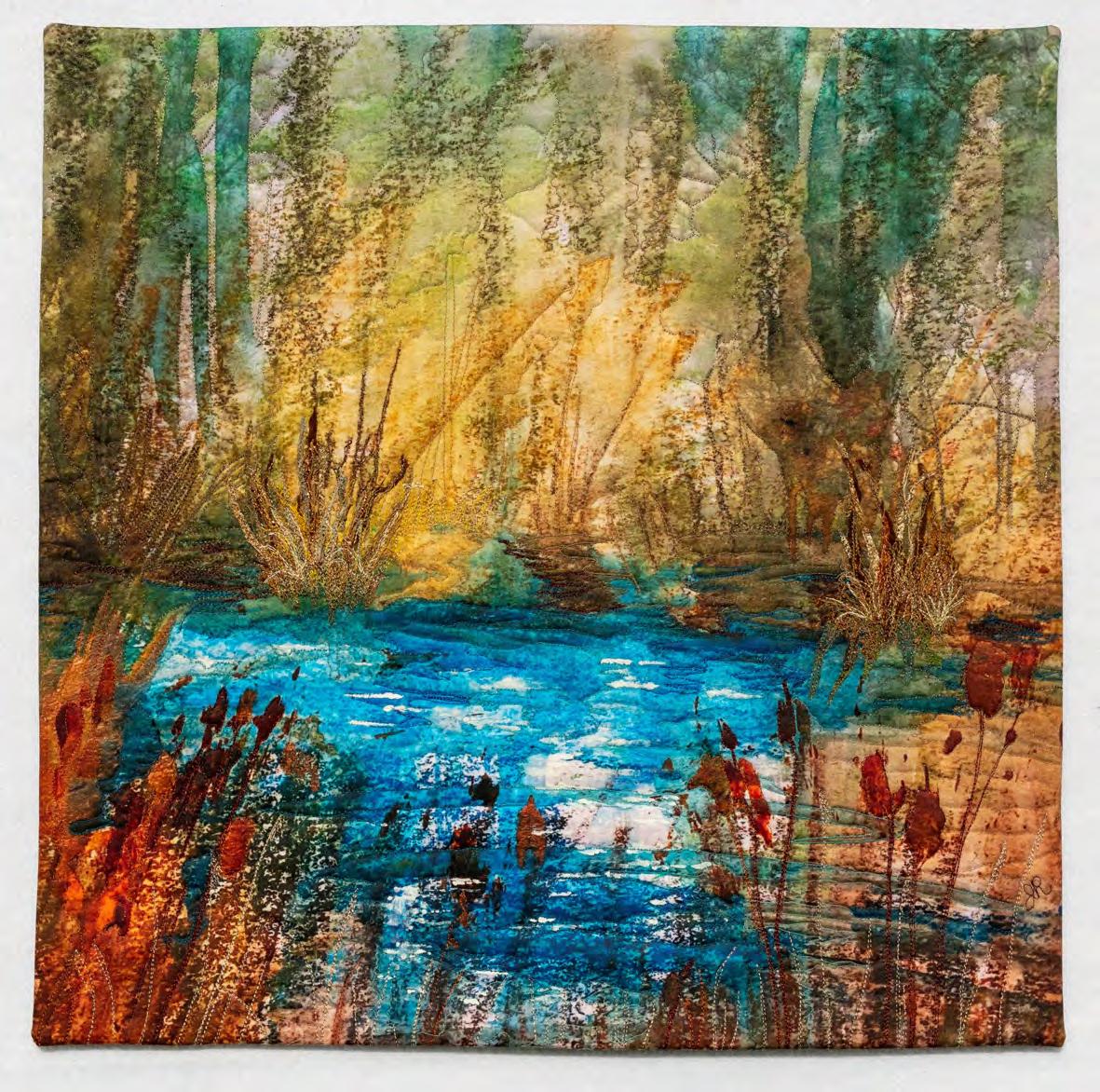
As a transplant to Virginia whose ancestors arrived from England in the seventeenth century, I have long been drawn to colonial history and imagining the ways those early settlers must have lived. The Historic Triangle (Williamsburg, Yorktown, and Jamestown) is a place I never tire of visiting. A couple of years ago, our family took a tall-boat cruise on the York River. This piece reflects the peace, joy, and freedom we felt by traveling on the beautiful waters of the mid-Atlantic, just as those ancestors must have done.
Sun-printed acrylic paint on cotton; hand-painted acrylic; machine piecing and machine quilting; couched silk cord. Materials include: cotton muslin; acrylic paint; silk cord; pieced batik border; cotton/wool batting; cotton thread.

Margaret Duncan Storti: I am a wife, mother, sister, and daughter who began stitching at about eight years old. I made many of my own clothes and designs throughout my teens. In college, I began to explore traditional piecework and quilting, but I always admired those whose textile work was far more art than function. I spent a number of years practicing traditional quilting, but for the past three, I have been exploring the process and elements of making art. I have a long way to go, but I am enjoying the journey. I hope you enjoy the fruits of my journey, too.
Facebook: Margaret Duncan Storti
Margaret Duncan Storti
Glen Allen, VA

Tidewater Sunset
Swampy areas are common along my walks: this place is neither land nor water. It is an inbetween place, a place where some might think it looks dead or scary, while to others it is fascinating and full of life. I remember walking through the woods with my mom, and she would tell me to look closely because fairies live in there. I still find myself looking closely because you never know what kind of treasures you might discover. Through the lens of a camera, I transform my images and experiences into fabric and stitch. I bring a little bit of nature home with me every day.
I love the look of rice paper with strands of fiber running through it, I thought it would be perfect for the water areas of my swamp quilt. I made a stencil for the reflections of the trees in the water and airbrushed using fabric paint. For the trees and the debris, I placed small pieces of fabric or yarns on top of a layer of cheesecloth and then placed between two layers of Super Solvy. I stitched through the layers to hold the pieces together and soaked them in water to dissolve the Solvy. Materials include: commercial and hand-dyed fabrics; rice paper; cheesecloth; assorted yarns; fabric paint; Sulky Super Solvy; cotton and polyester thread; cotton batting.
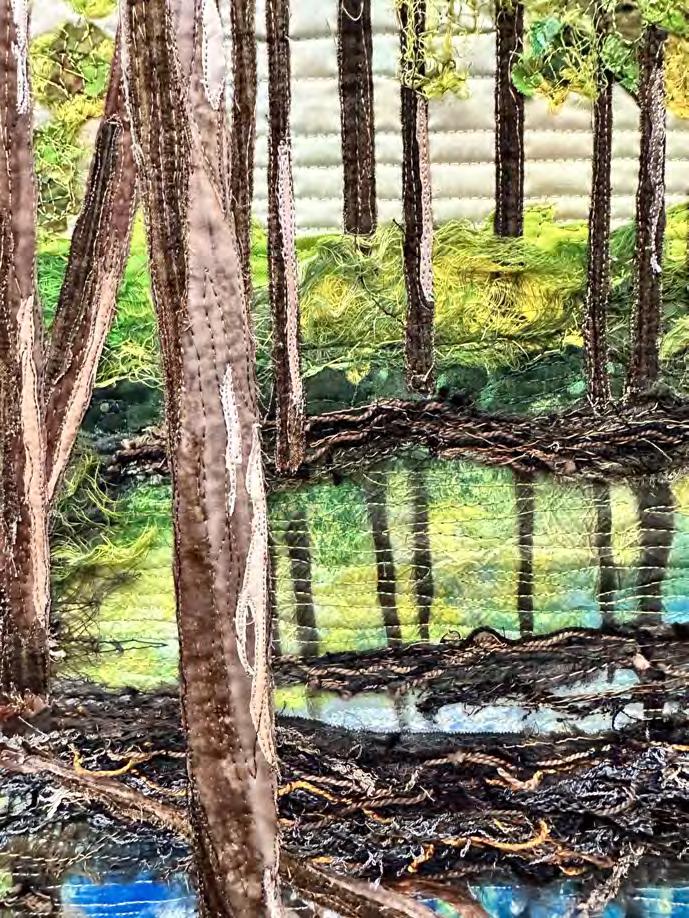
Pamela G. Swearingin: I have always had an artistic passion, and when I discovered art quilting a whole new world opened up. I have a bachelor’s degree in Landscape Design which included many architectural classes that I find helpful with quilt construction and design. During my married life we relocated to several Midwest states with our three children. When I eventually ended up in Kentucky, I became a manager of a bakery and explored the world of cake decorating. I have tried many forms of art: painting, printmaking, felting, photography, and my new form art quilts. I have recently started entering quilt and art shows and I have a few pieces published in artquilting magazine challenges. I currently live in Sunset Beach, NC.
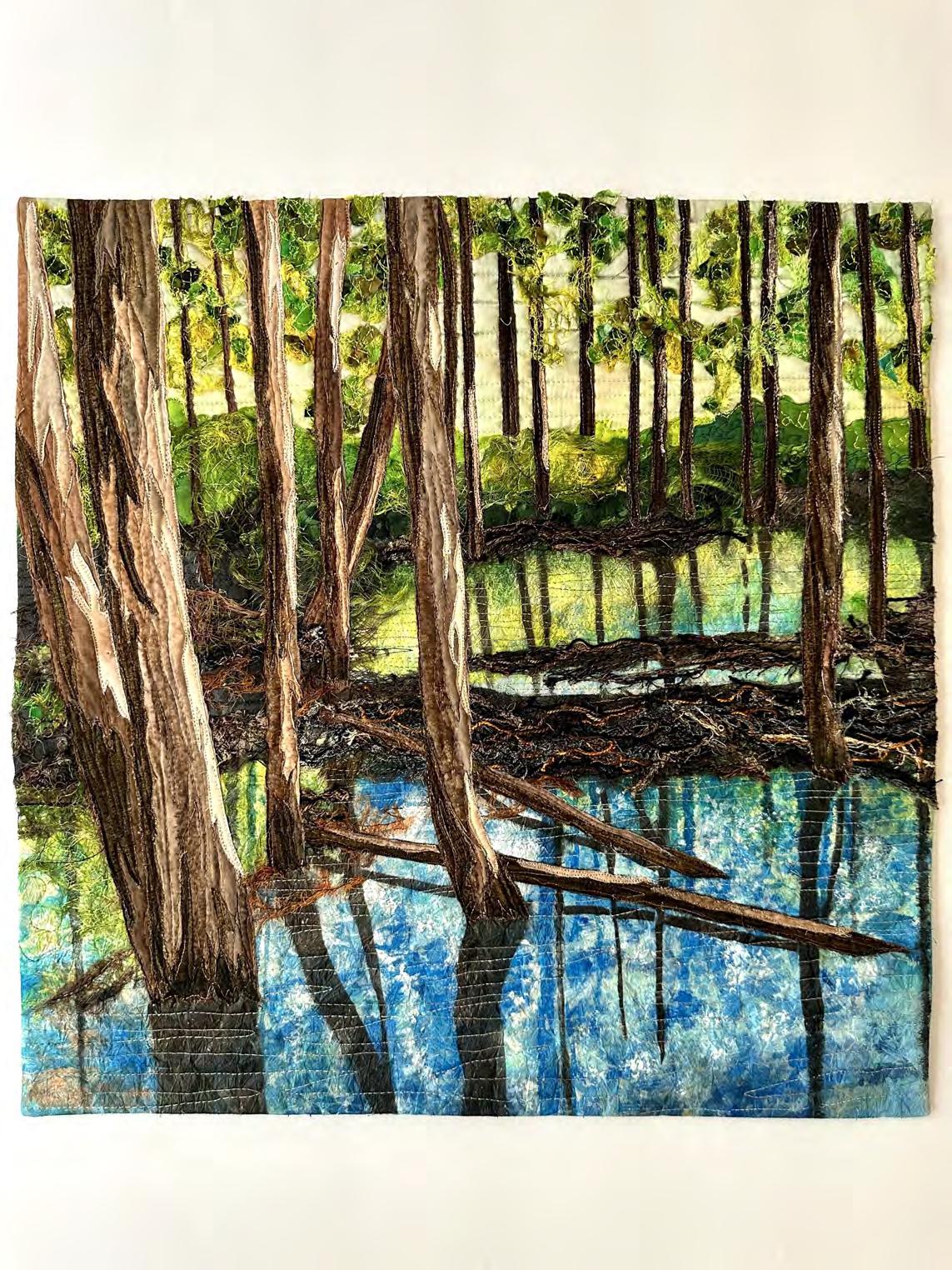
“Quiet Spirit” represents the beauty of nature. Although most of my art quilts express an affirmation or quotation, this one speaks silently of the details in my daily landscape. Ecoprinted fabric has been a passion of mine for a few years. The serendipity of the results brings me joy and fosters my curiosity. The leaves are all locally sourced in my Virginia neighborhood: included are walnut leaves, crape myrtle, and sage. The dogwood at the top of the quilt sits majestically in my backyard. It started as a contour drawing before I created it with scrap eco-print fabric using raw-edge appliqué. Free-motion stitching lets me play a bit and brings out the detail of the individual components. My quilts all include one of my sketchbook watercolor portraits. This young lady looks to me to be searching. The quilt serves as a reminder for me to slow down and appreciate the beauty in my everyday life.
The portrait is out of my sketchbook and transferred using a fabric pen and painted with various textile paints, while slowly adding detail with Inktense pencils. The cotton fabric is eco-print scraps of walnut, sage, and crape-myrtle leaves, which I free-motioned to the quilt base. Dogwood petals at the top are created with eco-printed fabric and raw-edge appliqué. Around the edges are embroidery-quilted details. The back of the quilt is formed with pieces from my vintage quilt collection. Materials include: cotton eco-printed fabric; batting; textile paint (Jacquard); Inktense pencils; embroidery floss; vintage quilt pieces for back fabric.
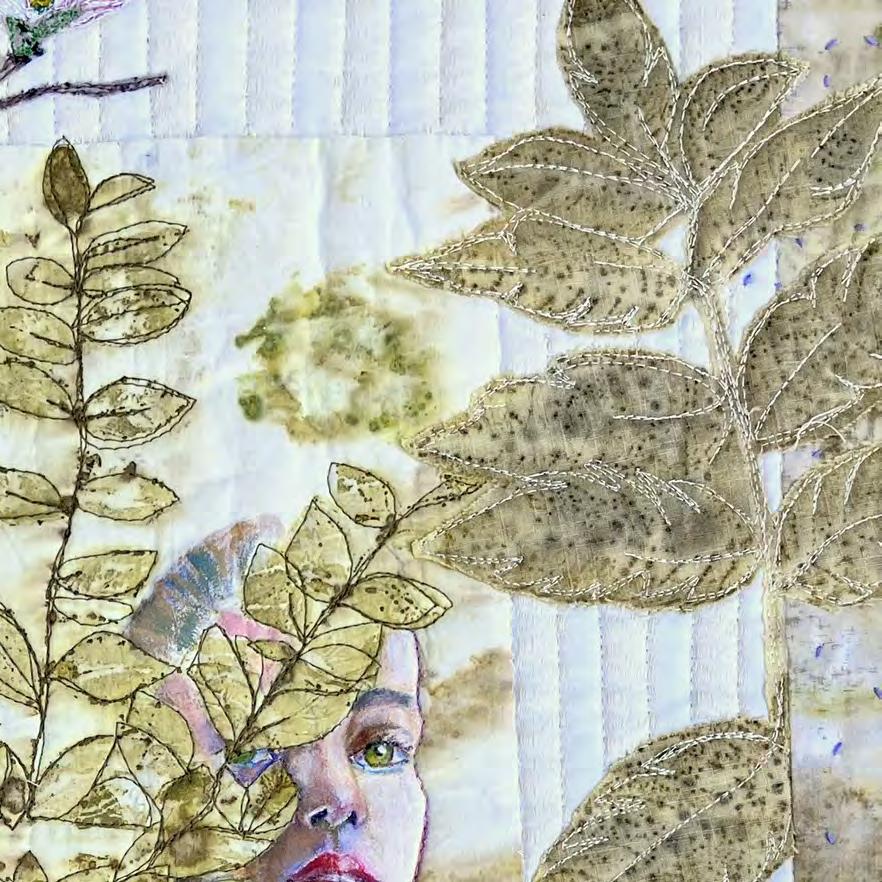
Naomi Swyers resides in Richmond, VA, where she works daily in a tiny home studio. After a long career as an elementary and middle-school art teacher, she is now trying to express her thoughts with textiles. She works and experiments with various media in her art journals and on fabric. A love for watercolor portraiture has developed into painting on fabric. Passionate about making a difference, her work includes many affirmations. Her art quilts and multimedia work have been in multiple juried exhibitions as well as solo shows. To learn more, follow along on Instagram (@findingmywaythrough fiber) She welcomes email and commission inquiries at nswyers00@gmail.com.
https://www.instagram.com/ findingmywaythroughfiber
Naomi Swyers
Richmond, VA

Quiet Spirit
In 1774, Thomas Jefferson purchased sixty-four acres of land, including the 215-foot high Natural Bridge, for twenty shillings from King George III of Great Britain. The natural arch, a limestone gorge carved out by Cedar Creek, has been a State Park since 2016.
Hand appliqué; free-motion machine quilting. Materials include: batik and commercial cotton fabrics; Hobbs Tuscany silk and half-layer wool batting; variegated cotton and polyester threads; Tsukinenko inks.

Karin Täuber’s international background inspires her quilting and helps her create. She comes from a very traditional quilting background, but with a lifelong love for photography, children’s books, and different art media. Karin specializes in quilts that tell a story: thoughtful, mystical, heartbreaking, or tongue-in-cheek. Creating art hasn’t been boring since the fairies moved into her studio!
https://www.karintauber.com
Karin Täuber
Blacksburg, VA

Natural Bridge
Virginia’s wetlands play a critical role in the state’s ecosystem. They filter the ground water and provide habitats for many species. Wetlands here and nationwide are disappearing. I am fortunate to live near two important and protected wetlands in northern Virginia Dyke Marsh and Huntley Meadows and enjoy their beauty. I was inspired by both of these local wetlands to create this image of reeds reflecting in the water. I love imagining the fauna hidden in the reeds .
Machine quilting; fusible appliqué. Materials include: cotton and silk commercial fabrics.
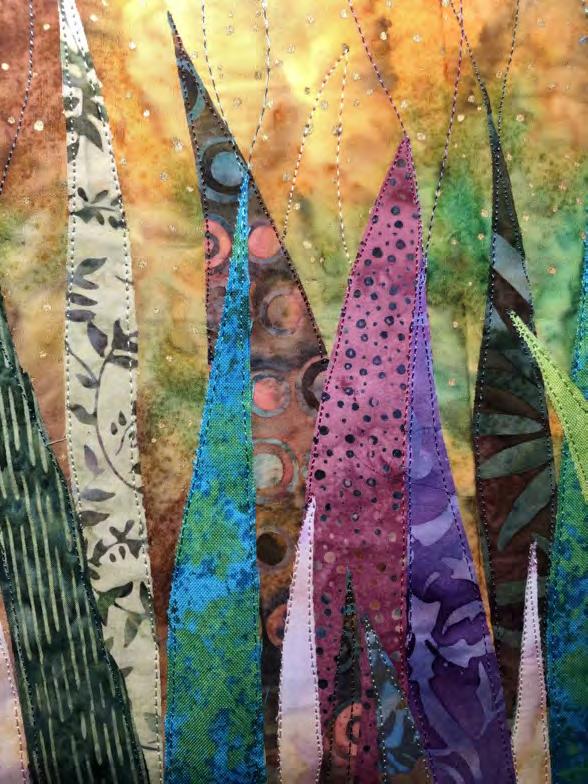
Betsy True: I am a fiber artist and photographer living in northern Virginia. After retiring from my career as a computer specialist with the Department of Defense, I became a full-time quilter. I love developing art quilts based on photographs I have taken .
https://betsytruedesigns.com
Betsy True
Alexandria, VA
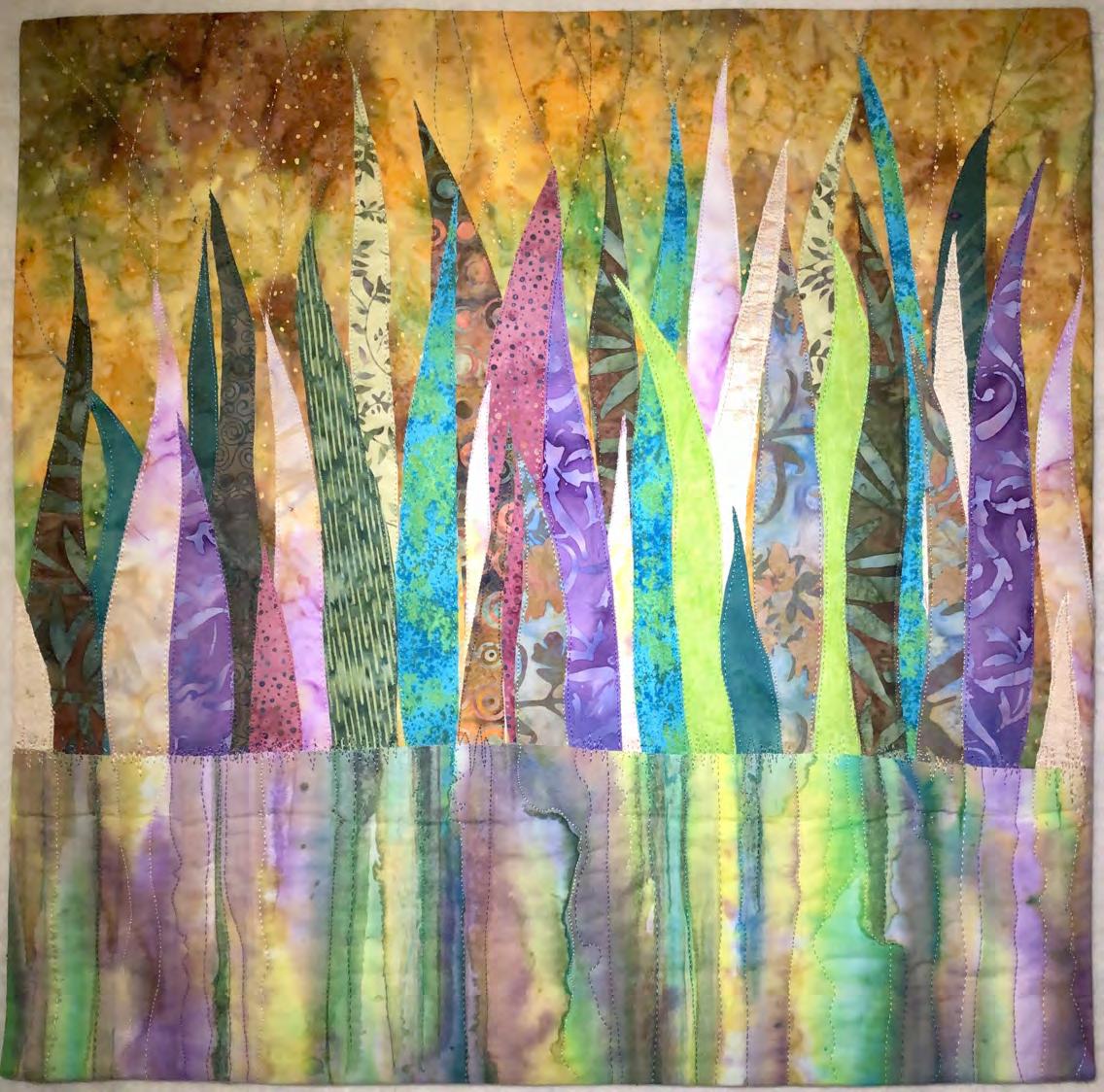
Wetlands Reflections
My current process involves the layering of digital imagery from my collages, quilts, and artist-printed fabrics. I am always surprised by the many unexpected reflections that occur during my manipulations.
Artist’s photograph with digital manipulation; machine quilting. Materials include: cotton sateen printed with artist’s imagery; cotton batting; cotton backing; polyester thread.

Kevin Womack is a textile artist living in Lynchburg, VA. In 1986, he was introduced to quilting by his maternal grandmother. Having always loved the legacy of family quilts, he decided to have her teach him the tradition. He was hooked from the first stitch. Kevin is passionate about hand-dyeing and patterning fabrics with surface-design techniques. He produces a line of unique fabrics and clothing for sale. Kevin teaches and lectures nationally.
https://www.kevinwomackart.com
Kevin Womack
Lynchburg, VA

Crossed Out
